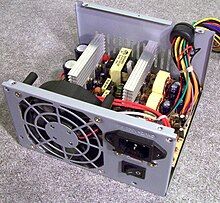Power supply unit[edit]
Main article: Power supply unit (computer)
The power supply unit (PSU) converts general-purpose mains AC electricity to direct current (DC) for the other components of the computer. The rated output capacity of a PSU should usually be about 40% greater than the calculated system power consumption needs obtained by adding up all the system components. This protects against overloading the supply, and guards against performance degradation.
Processor[edit]
Main article: Central processing unit
The central processing unit, or CPU, is a part of a computer that executes instructions of a software program. In newer PCs, the CPU contains over a million transistors in one integrated circuit chip called the microprocessor. In most cases, the microprocessor plugs directly into the motherboard. The chip generates so much heat that the PC builder is required to attach a special cooling device to its surface; thus, modern CPUs are equipped with a fan attached via heat sink.
IBM PC compatible computers use an x86-compatible microprocessor, manufactured by Intel, AMD, VIA Technologies orTransmeta. Apple Macintosh computers were initially built with the Motorola 680x0 family of processors, then switched to thePowerPC series; in 2006, they switched to x86-compatible processors made by Intel.
Motherboard[edit]
Main article: Motherboard
The motherboard, also referred to as system board or main board, is the primary circuit board within a personal computer, and other major system components plug directly into it or via a cable. A motherboard contains a microprocessor, the CPUsupporting circuitry (mostly integrated circuits) that provide the interface between memory and input/output peripheral circuits, main memory, and facilities for initial setup of the computer immediately after power-on (often called boot firmwareor, in IBM PC compatible computers, a BIOS or UEFI).
In many portable and embedded personal computers, the motherboard houses nearly all of the PC's core components. Often a motherboard will also contain one or more peripheral buses and physical connectors for expansion purposes. Sometimes a secondary daughter board is connected to the motherboard to provide further expandability or to satisfy space constraints.
Main memory[edit]
Main article: Primary storage
A PC's main memory is a fast primary storage device that is directly accessible by the CPU, and is used to store the currently executing program and immediately needed data. PCs use semiconductor random access memory (RAM) of various kinds such as DRAM, SDRAM or SRAM as their primary storage. Which exact kind is used depends on cost/performance issues at any particular time.
Main memory is much faster than mass storage devices like hard disk drives or optical discs, but is usually volatile, meaning that it does not retain its contents (instructions or data) in the absence of power, and is much more expensive for a given capacity than is most mass storage. As a result, main




